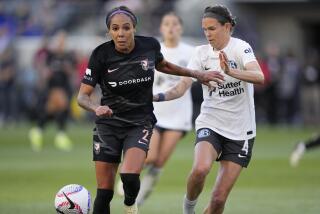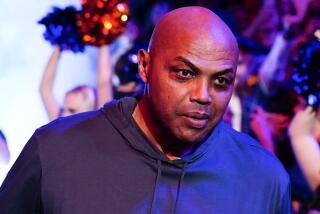NBA Players Have Questions on New Bargaining Pact
- Share via
WASHINGTON — For National Basketball Assn. players such as Frank Johnson, the new collective-bargaining agreement between the league and its players association represents exciting possibilities and a chance to perhaps recapture past glories. Commissioner David Stern, however, considers the contract as representing little more than the status quo.
In between the two extremes are many general managers and coaches wondering where the money to pay the players an average salary of $900,000 six years hence will come from and if they’ll be able to handle the athletes who’ll be receiving it.
Two weeks ago, the league and its players association, the NBAPA, agreed in principle to a new six-year collective-bargaining agreement that, among other things, reduced the NBA draft to three rounds this June and only two in subsequent years, continued the salary cap that limits a team’s payroll and altered the guidelines of the right of first refusal.
It is that last item that might have the greatest effect, both immediately and in the future. Previously, an NBA team could retain a free agent who received an offer from a second team by merely matching the amount of new contract. The team could then keep the player or trade him.
Under the new agreement, a team’s right of first refusal will be retained only for players ending their initial contract, or a negotiated extension of the first contract, who have been offered more than $250,000 by their former team.
Any NBA player with seven years or more experience whose second contract has expired is a free agent. Should he receive an offer and sign with another team, his former squad cannot retain his services or match the offer and try to trade him. To keep a seventh-year free-agent player, the original team must offer a raise of at least 25 percent above his previous salary.
After the 1988-89 season, unsigned players with four years experience will qualify under the new plan and after the 1993-94 season, players with three years experience are eligible.
As it stands today, 33 players will become unencumbered free agents at the end of the playoffs. With the exception of a few all-stars like Moses Malone, Sidney Moncrief and Tom Chambers, the group comprises players like Johnson, who has averaged 10.4 points and 5.1 assists during his seven seasons with the Washington Bullets.
Johnson was a free agent before the 1987-88 season but, due to foot injuries that limited him to 32 games the previous two seasons, there was little interest beyond Washington. In the Bullets recently concluded season, the guard played in 75 regular-season and all five playoff games, leading him to wonder how he’s regarded now.
“I think it will be very interesting,” he said. “I’m pretty excited. Last year at this time I really had no options, because of the foot injuries and because of the system. Now I think that I’ve proven that I can play, so we’ll see.”
For the NBA owners, the greatest fear is that the free agents will all go packing for Los Angeles, Boston and big money, glamour cities like New York and Chicago. Stern says the salary cap will prohibit that, and also reasons that a team still has plenty of time to ensure that its young talent won’t want to go anywhere else.
“If you have a guy you drafted for five years, that’s a pretty good shot,” he said. “All these negotiations (in sports) are over the concept of free agency. You can’t buy that from players, you can’t say, ‘Here, here’s $10, promise me that you won’t ask for this anymore.’
“That’s the thread that runs through talks, ‘If I don’t want to be here where can I go?’ That’s what we addressed. If a guy is intent on leaving, he’ll play out his contract and go. But the teams have an option. Take someone like Brad Daugherty. He likes Cleveland because they make him happy. Then the team gets into a winning situation and is competing for a championship. Everyone is happy, everything is good.”
Not quite, say some coaches. Despite all the talk about natural ability, the truth is that the Larry Birds and Magic Johnsons of the league got to the top because they worked harder than everyone else. Now, if everyone is making superstar money, said one Eastern Conference coach, “I don’t know how you’re gonna be able to coach guys anymore.
“You’re going to have to give guys four- or five-year deals to get them to stay with your team, and unless he is a superstar you know that he’s gonna take a year or two off somewhere down the line.”
Stern argues that such talk is an “almost racist approach.” He asks, “What’s uncoachable? Is Bruce Springsteen uncoachable? Does he tank it because he pulls down $1 million for a show? Is Michael Jackson uncoachable? If that happens, it only says something about the way teams select players, how they indoctrinate them and motivate them. I’ve seen Moses Malone in all-star games where he’s only getting $1,500 clearing guys out of the lane in a way that money can’t buy.”
By the end of the new contract between the league and the NBAPA, the salary cap of most teams will have almost doubled from the current $5 million. As in the old agreement, the players will receive 53 percent of gross revenues, which could bring an increase of about $400,000 to today’s average $500,000 salary.
“When we first heard about the new agreement, we went straight to our owner and asked him about it,” said the Eastern Conference coach. “He said everything was fine--it didn’t bother him at all. Either these guys (the league and its owners) are incredibly dumb or there’s more money around than we ever dreamed of.”
The answer surely lies closer to the second possibility. The league set an attendance record during the 1987-88 season, with the total gate increasing for the sixth straight season. Since 1983, NBA attendance has climbed more than 31 percent.
Currently, the league receives about $13 million from WTBS for the rights to broadcast games on cable television. Next season that amount increases to $23 million and the NBA will also begin talks with CBS for a new contract. In the next two seasons, four new franchises will enter the league. Each paid $32.5 million for that right and Stern adds that he expects all to be close to the top in both attendance and revenues.
Not only do those figures tell where the money is coming from, they also indicate why neither the league nor the players were anxious to force the issue and face the ramifications of a strike.
“What were the alternatives (to working out a new agreement)?” asks Stern. “Shutting down play, locking the players out, going to trial? For what and for whom?
“Really, what’s in this deal that’s beyond status quo? The draft? In two years there will be 27 teams selecting for two rounds each. That’s 54 players--when was the last time we had 54 rookies in the league at the end of the year?
“This is a good deal for both sides. Was there anything worth either side taking the risk of upsetting this particular apple cart?”
More to Read
Go beyond the scoreboard
Get the latest on L.A.'s teams in the daily Sports Report newsletter.
You may occasionally receive promotional content from the Los Angeles Times.










